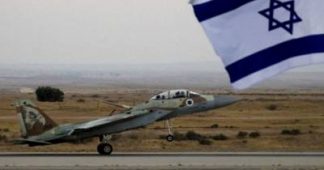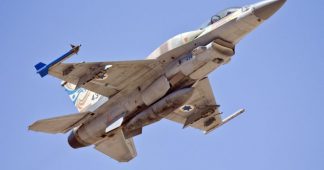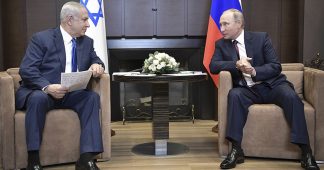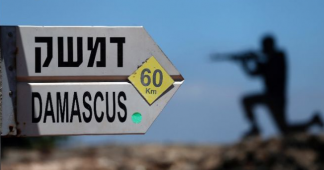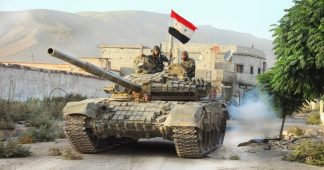By Elizabeth Tsurkov
February 14, 2018
As it becomes clear that Bashar al-Assad has stabilized his rule over the ruins of Syria, outside powers are stepping up their intervention in the country in an effort to shape an outcome that will secure their interests. Israel, which has remained relatively less involved than other actors, is now faced with regional rivals – Iran and its proxies – that have never been more powerful and emboldened. Israel is left to defend its interests with targeted airstrikes and by supporting ragtag rebel militias in southern Syria whose interests partially align with those of the Jewish state.
Interviews I have conducted with dozens of rebels, activists and civilians in southern Syria indicate growing Israeli involvement there. Israel’s increased entanglement stems from a growing realization that Russia and the United States are unwilling or unable to deal with Iran’s growing clout in Syria. However, this deeper involvement has created expectations among civilians and rebels in southern Syria of open-ended Israeli support, an expectation Israel is unlikely to meet. The predicament for Jerusalem illustrates the dangers of relying on American power to secure national interests in an era of U.S. retrenchment and disengagement from the global arena.
Jerusalem’s Cautious Approach
Iran and its proxies, which Israel perceives to be its biggest long-term threat in the region, are growing emboldened, as illustrated by the latest launch of an unmanned aerial vehicle into Israel. The Shia Lebanese militia Hizballah has been transformed by the Syrian civil war, gaining priceless combat experience in the country, especially due to close cooperation with the Iranian Revolutionary Guards Corps and Russian military advisers. Hizballah exponentially increased its arsenal in Lebanon, constructed permanent bases inside Syria, and recruited thousands of Syrians into local “Syrian Hizballah” militias. The stabilization of the Assad regime, in large part due to financial and military support from Iran, is a major success for Tehran. Clearly, Iran and Hizballah did not invest efforts in forming, arming and financing local Syrian militias, as well as erecting military bases in the country, for them to simply be dismantled once the war is over.
Initially, Israeli policymakers adopted a cautious approach to the civil war in Syria, focusing on preventing the transfer of advanced weapons to Hizballah, while avoiding choosing a side. Mindful of their government’s failures when it came to intervening in the prolonged civil war in Lebanon, Israeli policymakers wished to avoid entanglement in Syria. Syrian opposition members, most prominently former political prisoner Kamal Labwani and the self-appointed liaison to the Free Syrian Army’s Southern Front, Issam Zeitoun, told me they have repeatedly attempted to convince the Israeli government to establish a no-fly zone near the border fence in the Israeli-controlled Golan Heights. Those efforts failed miserably. According to two prominent Israeli activists involved in the humanitarian aid effort from Israel, Prime Minister Benjamin Netanyahu objected to a no-fly zone in southern Syria, fearing an attack on the zone would encourage more internally displaced Syrians to settle there. Netanyahu feared that an attack on the safe zone may drive the displaced to seek shelter in the Israeli-controlled Golan Heights. Syrian opposition leaders in southern Turkey, and rebel commanders in southern Syria, have told me that Jerusalem has rebuffed repeated efforts by Syrian rebel commanders to obtain support from Israel or to convince it to intervene militarily against the Assad regime directly.
Instead, until the Russian intervention in September 2015, Israel tried to work through the Obama administration by encouraging it to increase support for the Free Syrian Army’s Southern Front. Those efforts were also unsuccessful. The Obama administration wished to keep its involvement in Syria to a minimum, while Jordan grew increasingly disenchanted with the Syrian opposition and focused instead on limiting the number of new refugees entering its borders. At the same time, Israel provided limited humanitarian aid across the border and medical treatment to over 5,000 Syrians in Israeli hospitals.
Following the Russian intervention, some in the Israeli security establishment adopted the hopeful view that the Kremlin would replace Tehran as the main patron of the Assad regime and move Damascus away from Iran’s orbit. This would secure Israel’s main interest in the region without the need for deeper involvement. Instead, the Assad regime continued to play off its backers, Iran and Russia, to secure maximal support for its own goals. Israel established a deconfliction mechanism with the Russians and for the time being Russia is not preventing some Israeli strikes on Hizballah targets inside Syria. At the same time, Israeli officials acknowledge that Israel’s freedom to operate in Syria has been significantly curtailed due to the Russian intervention. A Russian veto prevented further Israeli retaliation for the downing of its jet earlier this month.
Israeli Involvement Grows
In 2016, Israel grew increasingly concerned as Assad’s regime stabilized and Iran’s and Hizballah’s presence in Syria expanded. Repeated Israeli appeals to the Obama administration to increase support for the rebels were rejected. During the end of President Barack Obama’s term and President Donald Trump’s first months in office, Russia spearheaded negotiations with Jordan, Turkey, opposition representatives and the United States regarding the establishment of deconfliction zones in Syria. Israel attempted to influence both America and Russia to protect its interests concerning the southern deconfliction zone, which abuts the Golan border fence. In dozens of meetings and visits to Washington and Moscow, Israeli officials first attempted to secure a guarantee that foreign Shia fighters would have to leave Syria. When this request was rebuffed by the Kremlin and ignored by Washington, Israel asked that those fighters not be allowed within 60 kilometers of the border fence. This request was ignored as well. Russia agreed to prevent the presence of foreign Shia fighters within five to seven kilometers from the Golan Heights, but made it clear that the guarantee was only temporary.
Throughout these failed negotiations, Israeli decision-makers came to the realization that they would have to protect Israel’s interests on their own. In September 2017, Israel began striking targets deeper inside Syrian territory, going beyond the “traditional” strikes on Hizballah’s weapon convoys near the Lebanese border. The targets now included regime military bases with a significant Iranian footprint.
Another major shift in Israeli policy occurred during this time as well, according to Syrian activists and rebels I have interviewed, as well as pro-regime and opposition media reporting. Rebels from Quneitra and western Daraa, as well as media activists in those regions with ties to the rebels, told me that Israel began providing more military support to a greater number of rebel groups affiliated with the Free Syrian Army. This support came in the form of weapons, ammunition and money to purchase weapons on the black market. All of my sources confirmed the identity of at least seven factions receiving Israeli support, on the condition that the groups would not be named. However, two of these groups have been publicly identified before: Liwaa’ Fursan al-Jolan and Firqat Ahrar Nawa. Israeli officials have vehemently denied support to jihadist groups, leaving open the possibility that the government supports these non-jihadist groups.
Some of the groups that started getting Israeli support in late 2017 were previously supported by the Military Operations Command, a CIA-directed center in Amman. Until January 2018, this center paid the salaries for tens of thousands of Free Syrian Army “Southern Front” fighters and provided them with materiel and ammunition. The Trump administration’s decision to shut down the center left rebel factions in southern Syria in desperate need for alternative sponsors.
Israel’s support is intended to protect the border area from encroachment by Iranian proxies, but also to enable the rebels to more effectively fight the local ISIL affiliate, Jaysh Khalid ibn al-Walid. According to Syrian rebels engaged in combating ISIL in western Daraa, Israel’s support includes not just materiel and cash, but also drone strikes and shelling with high-precision missiles on ISIL targets during defensive and offensive rebel operations in the Yarmouk basin. When ISIL launched an offensive on the rebels in January, Israeli strikes killed multiple ISIL fighters near al-Jabiliya. Most recently, the Israeli Defense Forces fired precision-guided anti-tank missiles at ISIL targets in western Daraa on Feb. 1, helping the rebels with another failed offensive. Despite this support, and Military Operations Command’s previous assistance to these groups, the rebels have been unable to advance against ISIL for more than three years.
Israel previously provided assistance to the besieged Beit Jann pocket in western Damascus, transferring medicine, medical equipment, food and diapers. Israel also provided cash to Iyad Moro, a former rebel commander and Israel’s contact person in Beit Jann, for the purchase of weapons on the black market, according to a rebel whose faction was operating in the area. As the Assad regime intensified its assault on the besieged area,Israel permitted several dozen rebels from Daraa and Quneitra to cross through the occupied Golan to Beit Jann in December 2017. This crossing was reported in the pro-Hizballah daily al-Akhbar and confirmed to me by four rebels in southern Syria.
Following the surrender of the Beit Jann pocket, some of these fighters were evacuated back to their homes in southern Syria through regime territory, while other rebels left for rebel-held Idlib. A third group, the largest, “reconciled” with the Assad regime and remained in their homes. Israel’s apparent involvement in the “reconciliation” negotiations ensured that these fighters will now serve as a regime-approved militia under Moro’s command, tasked with keeping both rebels and Iranian proxies away from the border fence. This agreement could possibly serve as a blueprint for future deals in southern Syria, which would aim to secure regime and Israeli interests, at the expense of both Iran and the rebels.
Humanitarian Aid – and Rising Tensions
Dozens of locals in Daraa and Quneitra have told me that Israel also increased the flow of humanitarian aid into southern Syria in recent months, sending construction materials and supplies for schools and hospitals and allowing non-Israeli volunteer doctors and nurses to enter Syria under the protection of an allied rebel group. This work was facilitated, in part, by the Multifaith Alliance for Syrian Refugees,” an American NGO that funnels aid into Syria from international charities. Some of these locals even sent me photos of items they received that they did not know how to use, such as mineral body scrubs.
The aid from Israel, which was once concealed or provided through the United Nations and other agencies, began appearing in the original packaging in Hebrew in 2016. Last year, Israel publicized for the first time the extent of the aid it has transferred into Syria, amounting to over 360 tons of food, 90 tons of clothes, and other much-needed items such as generators. Israel also began admitting women and children for day treatments in Israeli hospitals and continues to admit injured and sick Syrians, while Jordan largely sealed off its border. Thus, during the February 2017 rebel offensive on the Manshiye neighborhood in Daraa, Jordan did not allow injured rebels to enter for treatment (a policy Jordan has employed to deter unwanted rebel offensives on the regime), while Israel accepted them in large numbers, according to rebels and activists.
According to dozens of interlocutors in southern Syria, after initial opposition, Israeli aid is being warily accepted by a desperate population that feels abandoned by everyone else. Thousands of Syrians, particularly those residing in camps for the displaced along the border fence, are able to survive thanks to this aid. Syrians who return from medical treatment in Israel tell their friends and relatives about the high quality of the care and describe Israel as a beautiful and highly advanced country. Nevertheless, mistrust toward Israel lingers. In November, following a rebel offensive near the regime-controlled village of Hader, false rumors spread that the reason the offensive failed was heavy Israeli shelling on the rebels. The suspicion sometimes extends to the mundane: A contact in Quneitra sent me photos of hamburgers his family had received from a local distribution of Israeli aid, asking whether they were safe to eat because rumors spread among the local population that the meat was pork.
Some of Israel’s policies regarding aid distribution and its decision to cooperate with certain commanders but not others have created tensions in Quneitra and Daraa. These tensions erupted into violent clashes several times, most recently in November 2017, when an opposition-affiliated group attempted to rob an Israeli aid shipment, prompting an Israeli strike against the group.
False Hope
Israeli officials proclaimed time and time again that Israel is staying out of the war in Syria, only admitting to treating Syrians in Israeli hospitals and later to providing cross-border humanitarian assistance. However, as time went on, Israel has become more deeply entangled in events across the border fence. Israeli humanitarian assistance and military support have created a sense of hope among some rebels and civilians in southern Syria that Israel could serve as a reliable ally in their struggle against the Assad regime and protect them from its attacks. Reports from pro-regime outlets about Israel’s intention to establish the “safe zone” after all have added to this perception.
“What about the safe zones?” a rebel with Fursan al-Jolan asked me in December. When I replied that there did not appear to be any plan to establish such a zone, he responded, “But our relationship with Israel is good and we prevented the arrival of Hizbollah and Iran.”
Israel’s military establishment is entering relationships with rebel groups with a sense of distrust and even disdain. Despite what the rebels may wish, Israel will not attempt to overthrow the Assad regime, as Turkey, Jordan and the Gulf states have previously tried to do. Instead, Israel simply aims to secure its border, at least until another viable way emerges to keep Iranian-backed militias away from the Golan Heights.
Despite the Israeli annexation of the Golan Heights, illegal under international law, the border with Syria was Israel’s quietest until 2011 throughout the rule of Hafez and Bashar Assad. Thus, the Assad regime itself is not perceived as a threat – only its reliance on Iran. The current debate among leadership is whether an Assad regime takeover of southern Syria would serve Israeli interests. Some believe that such a takeover would displace ISIL from the border, which the rebels have been unable to accomplish for years, and that the regime would keep Iranian proxies away from border. These Israeli policy-makers would be content with a Syrian regime takeover of southern Syria, as long as Iranian proxies are kept from the border fence.
Israel’s initial regional strategy relied, to a large extent, on American leadership and involvement. When the priorities of the Obama administration shifted and the Trump administration largely disengaged from the region, Israeli leaders found themselves facing a resurgent Iran on their border. Attempts to convince Russia to protect Israel’s interests have produced only partial results – Israel gained freedom to operate against Hizbollah targets in Syria, but Moscow is unable or unwilling to keep Iranian proxies far enough from the border fence or to prevent the construction of Iranian bases in Syria.
Barring an unfathomable large-scale invasion of Syria and a direct intervention in a bloody civil war, Israel’s ability to shape reality in Syria is limited, yet the perceived threats are significant. All realistic Israeli options entail operating in an environment dominated by Russia, which has shown only limited desire or capacity to challenge Iran, since it needs Iranian-backed militias to help stabilize Assad’s rule. Thus, as Jerusalem continues to search for a permanent solution that will prevent Iran’s presence near the Golan, it finds itself relying on allies it recognizes are beset by factionalism and corruption and whose goals ultimately differ from its own.
The current balance of power, coupled with Assad’s drive to regain control of southern Syria, will likely result in the regime retaking the area. It remains to be seen whether Israel will manage to secure a deal that prevents Iranian proxies from entering the border region or acquiesces to their presence. What is clear is that relationships Israel has formed with the rebels, coupled with its increased humanitarian assistance to civilians, have created expectations among residents of southern Syria that Israel is unlikely to meet.
* Elizabeth Tsurkov is a Research Fellow focusing on Syria at the Israeli think tank, The Forum for Regional Thinking. She is a graduate student in political science at the University of Chicago and holds a Master’s degree in Middle Eastern studies from Tel Aviv University. She can be followed on Twitter @elizrael
Published at https://warontherocks.com/2018/02/israels-deepening-involvement-syrias-rebels/
